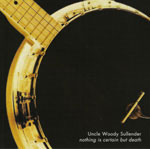Home » Jazz Articles » Album Review » Uncle Woody Sullender: Nothing is Certain but Death
Uncle Woody Sullender: Nothing is Certain but Death
Sullender, a former North Carolinian who now makes his home in Chicago, has played with Fred Lonberg-Holm's Lightbox Orchestra and is currently involved in an installation project with sound artist Maryanne Amacher. On Nothing is Certain but Death, the banjo is brought into electric as well as acoustic areas, and the Amacher influence certainly appears in the impossibly shrill "Sallie Goodman Breakdown"? (which samples "Sallie Goodman"? by Fiddlin' John Carson) and the savage electrc hair clipper slide that infuses "The Grain of the String."? Though the precedents for such a project as reinventing the banjo are few, Eugene Chadbourne does come to mind. Sullender has expanded its possibilities through a combination of nontraditional picking, extremely dissonant chords and hacked-apart rhythms (the exact reason why Bailey's guitar and Sullender's banjo both sound "prepared").
Yet technicality does not alone create new instrumental language, and like Chadbourne before him, Sullender has not only the technique but the frame of reference to make this project work: "Commonwealth Edison"? bounces from vaguely flamenco-inspired fragments to Appalachian dance music to mournful blues, all in a wrecked pastiche. Hawaiian luaus and mournful desert song conspire with Cageian plunks in the Lonberg-Holm duet "I Am in a Consumption"? (on which Lonberg-Holm's cello sounds distinctly "normal").
Of course, the banjo belies its identity whatever the context, and this is part of what makes Nothing is Certain such an interesting listen: no matter what part of the instrument is scraped or tautly plucked, the moment a note or a chord is used in even the most abstractly "traditional" manner, the instrument's true nature and all of its trappings shine through. That historical reference is a key, for though Charlie Christian does not often come through Derek Bailey's playing, no matter how distorted or augmented the Stanley Brothers are unavoidable in the music of Woody Sullender. It is somewhat comforting, then, that the record ends with two gleefully rickety improvisations, somewhat reminiscent of traditional Americana: "Don't say Goodbye Til I'm in Chicago"? and "Papa, Help me Across."?
With Nothing is Certain but Death, Woody Sullender has not so much brought the walls of the banjo down, but expanded their width and their breadth. What would an investigation of the instrument's language be without a firm understanding of its history, song, and trappings?
Track Listing
Commonwealth Edison; I am in a Consumption; Sallie Goodman Breakdown; From Hoggee to Hoggler; Aphelion Counting; The Grain of the String; Groundhog in the Courtyard; Dout T
Personnel
Woody Sullender (banjo, electronics on 3, 5, 6) Fred Lonberg-Holm (cello on 2) Jason Soliday (electronics on 5) Carol Genetti (voc on 8)
Album information
Title: Nothing is Certain but Death | Year Released: 2005 | Record Label: Dead CEO
< Previous
Jewels
Next >
Gonna Go Fishin'
Comments
Tags
For the Love of Jazz
 All About Jazz has been a pillar of jazz since 1995, championing it as an art form and, more importantly, supporting the musicians who create it. Our enduring commitment has made "AAJ" one of the most culturally important websites of its kind, read by hundreds of thousands of fans, musicians and industry figures every month.
All About Jazz has been a pillar of jazz since 1995, championing it as an art form and, more importantly, supporting the musicians who create it. Our enduring commitment has made "AAJ" one of the most culturally important websites of its kind, read by hundreds of thousands of fans, musicians and industry figures every month.


















